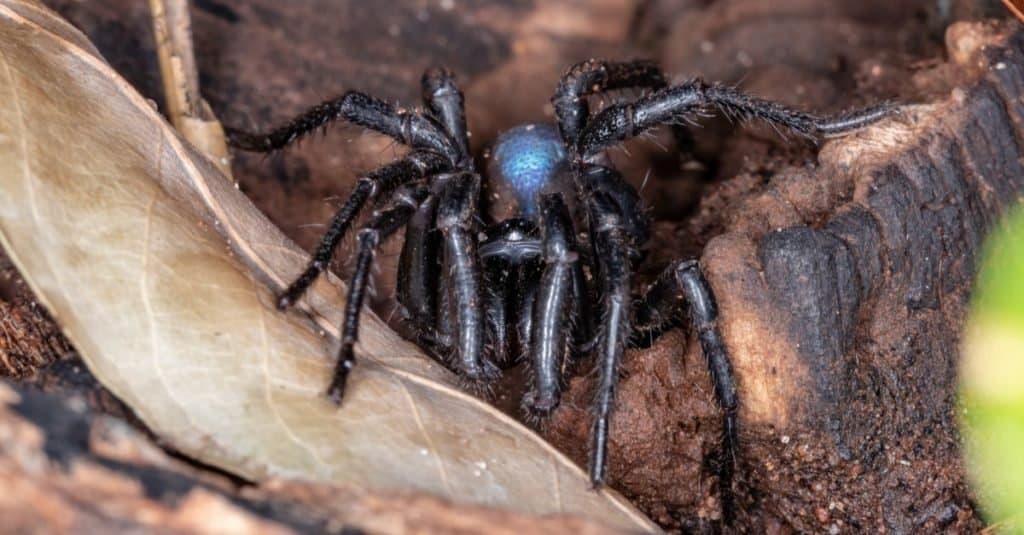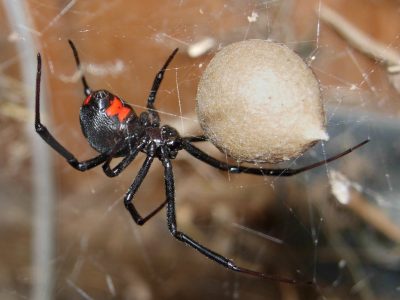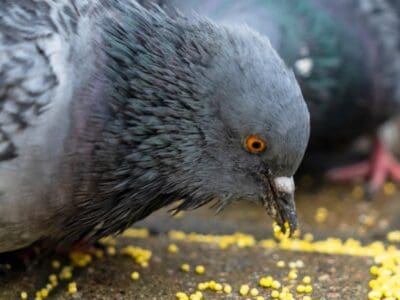Trapdoor spider
Ambush their prey using a trapdoor made of silk
Advertisement
Trapdoor spider Scientific Classification
Read our Complete Guide to Classification of Animals.
Trapdoor spider Conservation Status
Trapdoor spider Facts
- Prey
- Insects, arthropods, mice, birds, lizards, snakes, fish
- Main Prey
- Insects
- Name Of Young
- Spiderlings
- Group Behavior
- Solitary
- Fun Fact
- Ambush their prey using a trapdoor made of silk
- Biggest Threat
- Predators
- Most Distinctive Feature
- Develop unique cork, wafer, or folding trapdoors
- Distinctive Feature
- Large, thick legs and bodies with few hairs
- Other Name(s)
- Cork-lid trapdoor spider
- Average Spawn Size
- 100-300
- Habitat
- Forests, woodlands, grasslands, deserts, parks
- Predators
- Birds, scorpions, spiders, lizards
- Diet
- Carnivore
- Lifestyle
- Nocturnal
- Favorite Food
- Insects
- Common Name
- Trapdoor spider
- Special Features
- Mild neurotoxic venom
- Location
- Worldwide
- Nesting Location
- Burrows
Trapdoor spider Physical Characteristics
- Color
- Brown
- Grey
- Red
- Black
- Dark Brown
- Light Grey
- Dark Grey
- Grey-Brown
- Light-Brown
- Lifespan
- 5-20 years
- Length
- 0.4-1.5 inches
- Venomous
- Yes
- Aggression
- Medium
View all of the Trapdoor spider images!
Summary
One of nature’s greatest ambush hunters, trapdoor spiders create burrows that they cover with a trapdoor made of silk, hence their name. Several different families contain species commonly referred to as trapdoor spiders, although those belonging to the family Ctenizidae are often called the “true trapdoor spiders.” You can find trapdoor spiders worldwide in tropical, subtropical, and temperate regions.
5 Trapdoor Spider Facts
- Each trapdoor spider creates a specific type of trapdoor that varies in appearance from a wafer to a cork and operates via a fold or hinge.
- While male trapdoor spiders will venture out to find a mate, females almost never leave their burrows.
- Most trapdoor spiders are relatively harmless, but some, such as the mouse spider in the genus Missulena, possess a painful bite that can cause medical complications.
- Trapdoor spider burrows can measure up to 12 inches long and often reside near other burrows.
- Although trapdoor spiders primarily eat insects and other arthropods, they will occasionally eat small frogs, birds, snakes, mice, and fish.
Trapdoor Spider Species, Types, and Scientific Name
Most of the species commonly referred to as trapdoor spiders belong to the infraorder Mygalomorphae, which also contains notable arachnids such as tarantulas and Australian funnel web spiders. Several hundred species in at least 11 different families share the common name trapdoor spider. However, some consider the spiders belonging to the family Ctenizidae to be the “true trapdoor spiders.” In Greek, Ctenizade derives from the words ktenizein, meaning “combing” or “cleaning,” and the suffix -idae, meaning “belong to a family.” As their name implies, trapdoor spiders create silk structures that they use to cover their burrows. These structures’ appearance, function, and location have led to nominal variations of their common names. For example, folding trapdoor spiders in the family Antrodiaetidae create a door that they fold to open or close, while tree trapdoor spiders in the family Migidae sometimes live in the stems of tree ferns.
Some of the families with species that share the common name trapdoor spider include::
- Actinopodidae – mouse spiders
- Antrodiaetidae – folding trapdoor spiders
- Barychelidae – brush-footed trapdoor spiders
- Ctenizidae – “true” cork-lid trapdoor spiders
- Cyrtaucheniidae – wafer-lid trapdoor spiders
- Euctenizidaae – wafer-like or cork-like trapdoor spiders
- Halonoproctidae – wafer-like or cork-like trapdoor spiders
- Idiopidae – spurred trapdoor spiders or armored trapdoor spiders
- Migidae – tree trapdoor spiders or ridge-fanged trapdoor spiders
- Nemesiidae – tube trapdoor spiders
- Theraphosidae – also known as tarantulas, although several species create trapdoors
Appearance: How to Identify Trapdoor Spiders
Trapdoor spiders vary in appearance depending on the age, sex, and species of the spider. Generally speaking, female trapdoor spiders measure larger than males and feature different coloration. Most trapdoor spiders measure between 0.4 and 1.5 inches long, with an average of just under 1 inch long. While the majority of species have eight eyes, like most spiders, a few – such as those in the family Cyrtaucheniidae – have only six eyes. Trapdoor spiders range in color, although most appear in different earth tones, including black, brown, gray, or red. They typically have a scaly carapace, abdomen, and legs and feature fewer hairs than other spiders. Compared to orb weaver or sheetweb spiders, they possess thicker, more robust legs and pedipalps and typically have a flatter and more broad carapace.

Trapdoor spiders have a range of colors, including several earthtones. This mouse trapdoor spider is black.
©Vinicius R. Souza/Shutterstock.com
Habitat: Where to Find Trapdoor Spiders
You can find trapdoor spiders all over the world in a wide range of climates and habitats. While some are primarily found in tropical or subtropical forests or grasslands, others are endemic to temperate woodlands, meadows, and mountain areas. For example, trapdoor spiders in the family Ctenizidae range throughout Europe, particularly in Turkey, France and Italy. Meanwhile, folding trapdoor spiders in the family Antrodiaetidae live in the eastern and western United States and parts of Japan. Although most create their burrows in the ground, some construct their homes in more unusual locations. Trapdoor spiders in the family Migidae occasionally live in the stems of tree ferns, while some brushed trapdoor spiders in the family Barychelidae build burrows in rotted wood. Burrows can measure up to 12 inches deep and may contain multiple entrances depending on the species.
The common feature all trapdoor spiders share concerns their use of a trapdoor to seal their burrow. This trapdoor not only helps to protect them from predators but also serves as a great hiding spot to conceal the spiders from their prey. Trapdoor spiders create different types of silk trapdoors that vary in terms of their appearance, construction, and function. Trapdoor spiders make three main types of structures: wafers, cork, and folding doors. Wafer-like trapdoors contain relatively few silk strands and appear practically transparent, while folded trapdoors can be folded open or closed. Cork-like trapdoors are often considered “true” trapdoors and are the most common type of structure made by trapdoor spiders. Cork-like trapdoors open via a hinge and often contain a mixture of silk strands, dirt, and vegetation.
Diet: What Do Trapdoor Spiders Eat?
Like all spiders, trapdoor spiders are carnivores that predominantly prey on insects and other arthropods. The majority of trapdoor spiders sleep during the day and are most active at night. They are ambush hunters that wait for their prey to come to them. Once their prey gets close enough, they lunge forward and use their powerful fangs to drag the meal back to their burrows. Trapdoor spiders prey on a wide variety of insects and arthropods, including crickets, grasshoppers, beetles, and praying mantes. Some trapdoor spiders can even take down small vertebrates such as birds, lizards, frogs, mice, and fish. While typically harmless to humans, trapdoor spiders possess mild neurotoxic venom that they use to break down and immobilize their prey. That said, mouse spiders in the genus Missulena of the family Actinopodidae have been known to deliver painful bites that can cause mild medical complications on rare occasions.
Prevention: How to Get Rid of Trapdoor Spiders
Due to their secretive nature, it can prove difficult to find and eliminate trapdoor spiders. Additionally, some people consider them beneficial as they prey upon various common crop pests. That said, you may want to remove these spiders if you find them around your property. If you find a trapdoor spider outside of its burrow, you can trap it under a glass so you can remove it at your convenience. And if it won’t come out of its burrow, it most likely won’t pose a future problem.
Related Animals
View all 133 animals that start with TTrapdoor spider FAQs (Frequently Asked Questions)
Are trapdoor spiders dangerous?
Most trapdoor spiders aren’t dangerous, although their bites can be painful. That said, spiders in the genus Missulena have a bite that can cause medical complications.
How many legs do trapdoor spiders have?
Like all spiders, trapdoor spiders have eight legs.
How do you identify trapdoor spiders?
Trapdoor spiders usually measure around 1 inch long, appear dark brown or black, have few hairs, and live in burrows covered with a silk trapdoor.
How do you get rid of trapdoor spiders?
To get rid of a trapdoor spider you can catch it and release it far from your house.
Thank you for reading! Have some feedback for us? Contact the AZ Animals editorial team.
Sources
- Anthropod, Available here: https://arthropod.uark.edu/trapdoor-spider/
- UCANR.edu, Available here: https://ucanr.edu/blogs/blogcore/postdetail.cfm?postnum=43886
- Entomology Today, Available here: https://entomologytoday.org/2020/11/17/researchers-find-endangered-living-fossil-trapdoor-spider-cryptocteniza-kawtak/
- Insect Identification, Available here: https://www.insectidentification.org/insect-description.php?identification=Cork-Lid-Trapdoor-Spider
- Bing, Available here: https://www.bing.com/search?q=cork+lid+trapdoor+spider&FORM=QSRE1


















